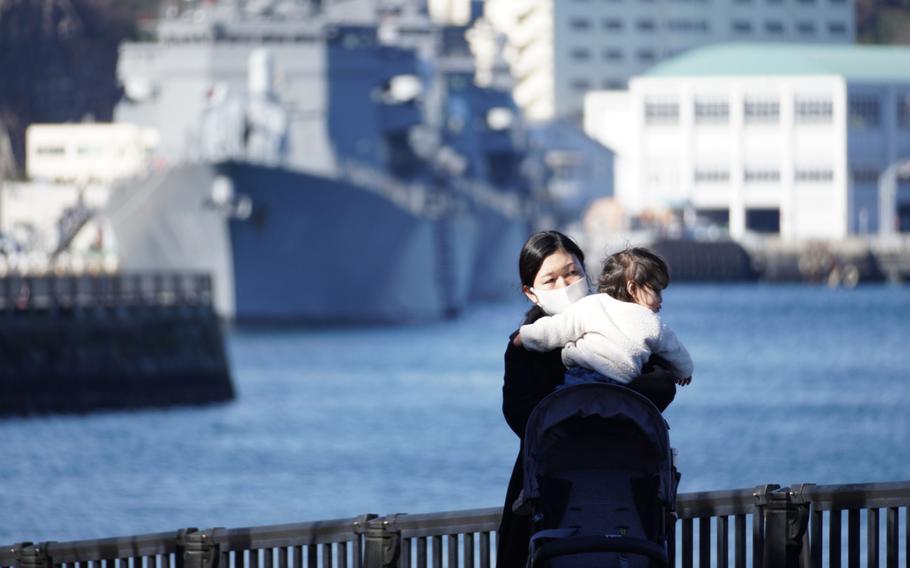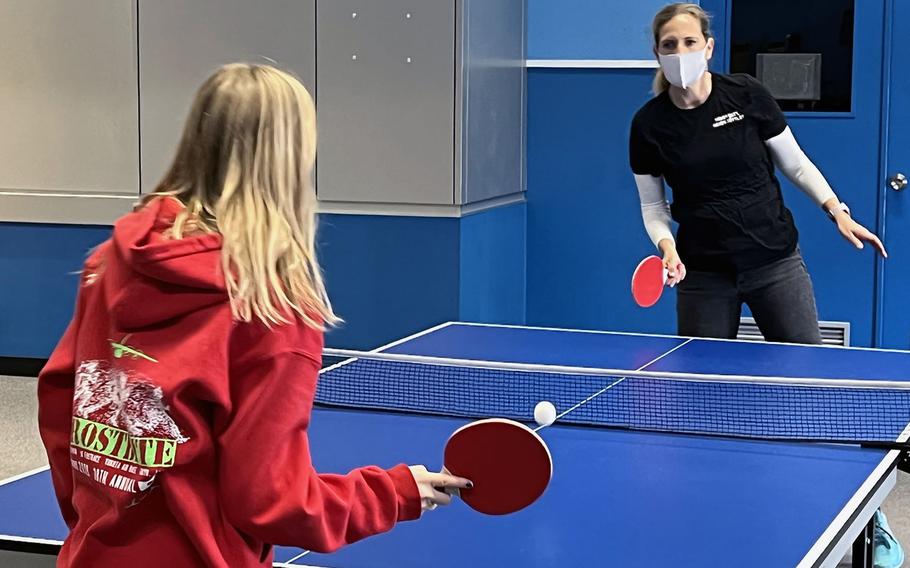
A mother wears a mask while holding her child near Yokosuka Naval Base, Japan, Tuesday, Jan. 18, 2022. (Akifumi Ishikawa/Stars and Stripes)
Stars and Stripes is making stories on the coronavirus pandemic available free of charge. See more stories here. Sign up for our daily coronavirus newsletter here. Please support our journalism with a subscription.
TOKYO —The sixth wave of COVID-19 in Japan gained strength Tuesday, rising to a daily total of 32,197 new cases and exceeding the previous peak reached six months ago, according to Japanese media.
A government panel could recommend a modified state of emergency, or quasi-emergency, in 11 prefectures, including Tokyo, on Wednesday due to the spike in cases nationwide, Japanese media reported Tuesday.
Three other prefectures, including Okinawa, are already under a quasi-emergency. The new emergency may last three weeks, according to reports. The government would ask bars and restaurants to close early and refrain from selling alcohol, among other measures.
The U.S. military in Japan as of 6:30 p.m. Tuesday had not reported its total COVID-19 infections from the holiday weekend around Martin Luther King Jr. Day. It last confirmed 715 new infections across 17 military installations on Friday.
Yokota Air Base, the headquarters of U.S. Forces Japan in western Tokyo, reported 138 new cases between Jan. 12 and Tuesday, for a 273 active cases, according to the base website. Most new infections, 130, were acquired locally and eight tested positive after recently arriving in Japan.

Military spouse Elizebeth Frost and her daughter, Madeline Frost, wear masks during a game of table tennis at Yokota Air Base, Japan, Jan. 14, 2022. (Kelly Agee/Stars and Stripes)
The U.S. military population throughout Japan remains under a two-week order to stay on their bases or in their off-base homes until Monday.
A USFJ spokesman could not be reached by phone or email Tuesday for comment on how a quasi-emergency in Japan would affect the stay-at-home order.
U.S. personnel under the status of forces agreement must abide by the order for another week except for trips to grocery stores, medical appointments and other essential services. SOFA outlines the rights and responsibilities of those in Japan with the U.S. military.
Japan’s total case numbers increased from 17,940 on Friday to 22,707 on Sunday before reaching a new pandemic high on Monday of 26,801, according to the World Health Organization.
The nation’s second-largest metro area, Osaka prefecture, was expected to confirm more than 6,000 new COVID-19 cases Tuesday, a one-day pandemic record there, according to public broadcaster NHK.
Since March 2020, Japan has recorded 1.9 million cases and 18,429 deaths related to COVID-19, according to the Johns Hopkins Coronavirus Resource Center. In the past week, 30 people have died, far below the record 797 deaths recorded during a week in May.
Tokyo added another 5,185 newly infected people, public broadcaster NHK reported Tuesday, to the 11,452 cases of COVID-19 the metropolitan government reported Saturday, Sunday and Monday. Tuesday’s figure is more than five times the number one week prior and 723 individuals short of a pandemic record, according to metro government data.
New infections in the capital city declined from 4,561 on Saturday to 3,719 on Monday, according to metro data. The seven-day running average on Monday was 3,255.3, an increase of about 407 new cases on average over the previous day.
Nearly 1,500 people were hospitalized in Tokyo, five of them with severe symptoms, as of Monday, according to metro data. About 3,730 beds remain available.
About one in five beds designated for coronavirus patients is now occupied, a benchmark set by Tokyo Mayor Koike Yuriko for seeking further measures to curb the virus’ spread, NHK reported Monday
At Yokosuka Naval Base south of Tokyo, the base suspended preschool programs at two child development centers, Duncan and Gridley, due to COVID-19 infections in staff and children, according to an announcement Saturday on the official Yokosuka Facebook page.
Also, the base Chief Petty Officers Club suspended its operations “until infected staff are recovered, and others may return to work following quarantine,” according to the same post.
The base, homeport of the U.S. 7th Fleet, reported 239 new cases Friday for 328 total, and no hospitalizations for COVID-19, according to a base news release.
Farther south, Sasebo Naval Base on Kyushu Island reported 44 people tested positive for COVID-19 since Thursday, for 132 active cases, according to the installation’s official Facebook page. Of the new cases, 38 fell ill, the post said.
At Marine Corps Air Station Iwakuni, 25 miles south of Hiroshima, the daily case count dropped to eight newly infected individuals on Monday, according to a base news release. If that trend holds, the air station’s record coronavirus surge may be ending.
MCAS Iwakuni has reported 915 individuals infected with the coronavirus since Christmas weekend. Most of those, 769, surfaced in January. By comparison, the base reported 294 cases through all of 2021.
However, hospitalizations for COVID-19 totaled only two on Friday, according to the most recent update by U.S. Forces Japan. It reported no severely ill patients.